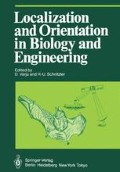Abstract
Flying animals have six degrees of freedom of movement in space: three of translation along their body axes (lift, slip, thrust), and three of rotation about these axes (yaw, pitch, roll). For aerodynamical reasons, however, they maintain on average a characteristic flight attitude, i.e. a particular orientation of their body with respect to the gravity field. Translatory and yaw movements have little influence upon flight stability, but pitch and roll movements involve the risk of crashing. Consequently such movements must be rigidly controlled, especially in highly manoeuvrable animals like flies.
Access this chapter
Tax calculation will be finalised at checkout
Purchases are for personal use only
Preview
Unable to display preview. Download preview PDF.
References
Blondeau J, Heisenberg M (1982) The three-dimensional optomotor torque system of Drosophila melanogaster. Studies on wildtype and the mutant optomotor blind H31. J Comp Physiol 145:321–329.
Buchner E (1976) Elementary movement detectors in an insect visual system. Biol Cybern 24: 85–101.
Buddenbrock W von (1915 b) Über das Vorhandensein des Lichtrückenreflexes bei Insekten sowie bei dem Krebse Branchipusgrubei. Sitz Ber Heidelberger Akad Math Nat Kl Abt B5, 1-10.
Carpenter RHS (1977) Movements of the eyes. Pion, London.
Götz KG, Hengstenberg B, Biesinger R (1979) Optomotor control of wing beat and body posture in Drosophila. Biol Cybern 35:101–112.
Hausen K (1983) The lobula complex of the fly: Structure, function, and significance in visual behaviour. In: Ali MA (ed) Vision in invertebrates. Plenum, London New York.
Hengstenberg R (1981) Visuelle Drehreaktionen von Vertikalzellen in der Lobula Platte von Calliphora. Verh Dtsch Zool Ges 1981, S. 180. G Fischer, Stuttgart.
Hengstenberg R (1982) Common visual response properties of giant vertical cells in the lobula plate of the blowfly Calliphora erythrocephala. J Comp Physiol 149:179–193.
Hengstenberg R, Hausen K, Hengstenberg B (1982) The number and structure of giant vertical cells (VS) in the lobula plate of the blowfly Calliphora erythrocaphala. J Comp Physiol 149: 163–177.
Hengstenberg R, Sandeman DC, Hengstenberg B (in preparation) Compensatory head roll of the blowfly Calliphora, elicited during flight by mechanical and visual stimuli.
Horn E, Lang HG (1983) Positional head reflexes and the role of the prosternal organ in the walking fly Calliphora erythrocephala. J Comp Physiol 126:137–146.
Pflugstaedt H (1912) Die Halteren der Dipteren. Z Wiss Zool 100:1–59.
Pringle JWS (1948) The gyroscopic mechanism of the halteres of Diptera. Philos Trans R Soc Lond [Biol] B 233:347–384.
Sandeman DC (1977) Compensatory eye movements in crabs. In: Hoyle G (ed) Identified neurons and behaviour of arthropods. Plenum Press, New York.
Sandeman DC, Markl H (1980) Head movements in flies (Calliphora) produced by deflexion of the halteres. J Exp Biol 85:43–60.
Schneider G (1953) Die Halteren der Schmeißfliege Calliphora als Sinnesorgane und als mechanische Flugstabilisatoren. Z Vergl Physiol 35:416–456.
Srinivasan MV (1977) A visually-evoked roll response in the housefly. Open-loop and closed-loop studies. J Comp Physiol 119:1–14.
Tracey D (1975) Head movements mediated by halteres in the fly Musca domestica. Experientia 31:44–45.
Wienrich M (1979) Untersuchung des neuromotorischen Erregungsmusters in direkten Flugmuskeln von Fliegen, die während des Fluges um ihre Hochachse gedreht werden. Diplomarbeit, Math Nat Fak Univ Düsseldorf.
Author information
Authors and Affiliations
Editor information
Editors and Affiliations
Rights and permissions
Copyright information
© 1984 Springer-Verlag Berlin Heidelberg
About this paper
Cite this paper
Hengstenberg, R. (1984). Roll-Stabilization During Flight of the Blowfly’s Head and Body by Mechanical and Visual Cues. In: Varjú, D., Schnitzler, HU. (eds) Localization and Orientation in Biology and Engineering. Proceedings in Life Sciences. Springer, Berlin, Heidelberg. https://doi.org/10.1007/978-3-642-69308-3_25
Download citation
DOI: https://doi.org/10.1007/978-3-642-69308-3_25
Publisher Name: Springer, Berlin, Heidelberg
Print ISBN: 978-3-642-69310-6
Online ISBN: 978-3-642-69308-3
eBook Packages: Springer Book Archive

